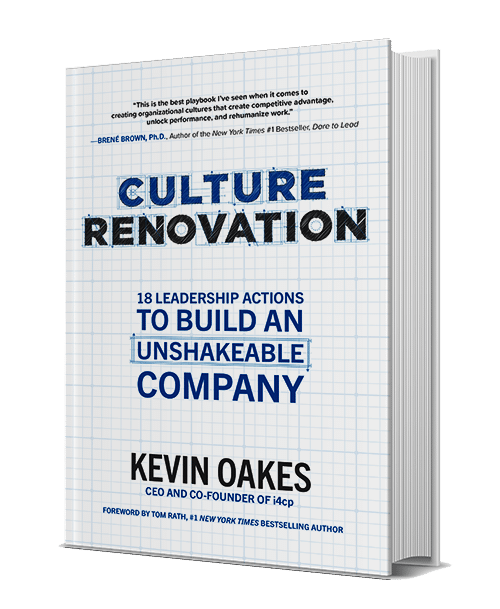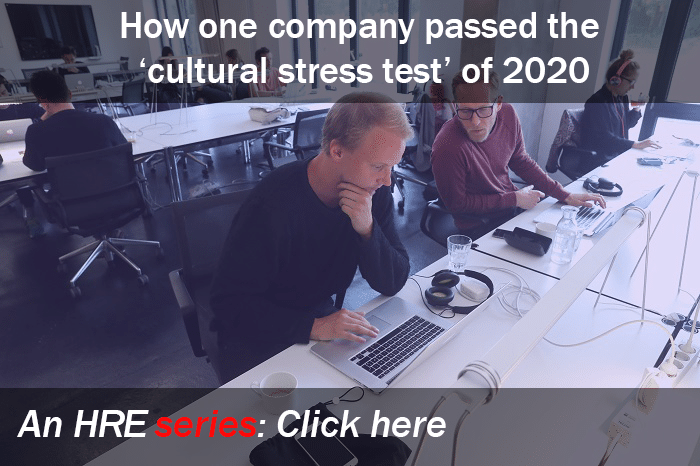 The link between a dynamic culture and organizational performance has been well-documented. While leaders understand the correlation, most efforts to improve corporate culture fall flat. In his new book, Culture Renovation: 18 Leadership Actions to Build An Unshakeable Company, Kevin Oakes, CEO and co-founder of the Institute for Corporate Productivity, makes the case for creating a powerful culture that delivers tangible business benefits by enhancing what works and overhauling what doesn’t.
The link between a dynamic culture and organizational performance has been well-documented. While leaders understand the correlation, most efforts to improve corporate culture fall flat. In his new book, Culture Renovation: 18 Leadership Actions to Build An Unshakeable Company, Kevin Oakes, CEO and co-founder of the Institute for Corporate Productivity, makes the case for creating a powerful culture that delivers tangible business benefits by enhancing what works and overhauling what doesn’t.
With the COVID-19 pandemic driving many organizations to remote work, companies are struggling to measure and improve their culture. While the study referenced in Oakes’ book was undertaken prior to the shift to remote work, its findings remain relevant, as culture initiatives are more important than ever.
HRE recently caught up with Oakes to discuss what it means to renovate culture, when companies should embark on such an initiative and what corporate culture has in common with a beautiful, old house. The book will be released Jan. 19.
Kevin Oakes, CEO and co-founder of the Institute for Corporate Productivity
HRE: Tell us about the premise behind Culture Renovation.
Oakes: A lot of companies set out to make changes to their culture, but only about 15% actually succeed. My book is based on a research study around what those companies are doing to positively impact their culture. From that, we came up with a blueprint of 18 leadership actions that the senior executive team and HR, working together, can make inside of an organization to have that positive culture change.
HRE: You compare the process of creating a powerful culture to renovating a historic house. Please explain.
Oakes: With a historic house, there are elements that are timeless that you want to hang on to. You keep those elements, while upgrading for the future with new technology and new ways of doing things that increase the value of your house long-term. The same concept applies to companies. Successful companies don’t transform their organization. They renovate their culture, meaning they keep the values and traits that have made them successful, build upon them and recognize what they need to create to increase the value of the organization long-term.
HRE: When should an organization undertake a culture renovation?
Oakes: The best time to do a culture renovation is when you’re not in dire straits. Unfortunately, most culture change efforts are ignited by certain events. You’ve had a poor couple quarters, earnings are down, the share price is down, you’ve done an acquisition or you’ve had a CEO change. The best companies don’t wait for those events. When everything’s going well, that’s when they think about how they can become agile for the future and prepare for the future.
HRE: How does an organization go about determining what features to keep and what needs to be renovated?
Oakes: If you’re relying on your annual engagement survey as a measure of culture, that’s a false proxy. Those are point-in-time exercises. Most smart companies ask the workforce some kind of sentiment question on at least a weekly basis to understand what the culture is today. It’s important that the senior team has a good understanding of what the workforce values. What is the workforce experience that will help us figure out what we need to keep and what we need to change?
 HRE: You stress the importance of identifying what you call influencers, energizers and blockers. Tell us about each of those and the role they play in a culture renovation.
HRE: You stress the importance of identifying what you call influencers, energizers and blockers. Tell us about each of those and the role they play in a culture renovation.
Oakes: If you think about your own personal interactions with individuals, there are certain people where you leave a conversation feeling energized, and there are others where it’s like talking to Darth Vader. They just suck the life out of the room, and you walk away depressed and de-energized. If you’re trying to have positive culture change, you really want to tap into those influencers and energizers. Those are the people that are going to be those culture ambassadors long-term, while the de-energizers are the ones that are going to slow things down and thwart culture change efforts long-term.
See also: Why we need culture-makers right now
HRE: A lot of organizations look at something like this as “Check-the-box. OK, we’ve done it. Let’s move on to something else.” Is that a common mistake?
Oakes: Absolutely. You can’t set a flag in the ground and have a declaration that you’re finished. It’s a constant effort. Smart companies recognize they’ve got to constantly look at how they are going to future-proof their organization, adapt and be agile as the market changes going forward and have a culture that’s going to bring out the best in their workforce.
HRE: There are so many books on culture. Where do you see yours fitting in?
Oakes: There are a lot of books that talk about how culture is amorphous, but nobody talks about the practical tactical steps to make changes to culture. That’s what we set out to do. This book is a blueprint for companies to follow, based on research on successful culture changes. However, we also recognize there are techniques and tricks and other things companies have done that aren’t in the book, so we set up a website where companies can share what’s worked for them. This conversation on how to successfully renovate culture is probably never going to be over, so we want to make sure there’s a mechanism in place to allow the conversation to continue.